News
-
 Pranayama workshop, Mar 1-7
Pranayama workshop, Mar 1-7
-
 21-day Pranayama challenge
21-day Pranayama challenge
-
 Nāda meditation workshop, January 8-12
Nāda meditation workshop, January 8-12
-
 April 3, Navaratri with Yogi Matsyendranath Maharaj, Australia, Queensland
April 3, Navaratri with Yogi Matsyendranath Maharaj, Australia, Queensland
-
 March 17, 2020. Purifiying Pranayama With Yogi Matsyendra Nath
March 17, 2020. Purifiying Pranayama With Yogi Matsyendra Nath
-
 November 2019, Tantra Workshop Series in Argentina
November 2019, Tantra Workshop Series in Argentina
-
 Workshop in Gualeguaychu
Workshop in Gualeguaychu
-
 17-18 November 2018, Yogi Matsyendranath in Źarate (Argentina)
17-18 November 2018, Yogi Matsyendranath in Źarate (Argentina)
-
 15-16 November 2018, Yogi Matsyendranath visit to Uruguay
15-16 November 2018, Yogi Matsyendranath visit to Uruguay
-
 12 Nov 2018, Lecture at USAL (Salvador University)
12 Nov 2018, Lecture at USAL (Salvador University)
-
 10-11 November 2018, Workshops in Quilmes and La Plata (Argentina)
10-11 November 2018, Workshops in Quilmes and La Plata (Argentina)
-
 8 November 2018, Open conference in Necochea (Argentina)
8 November 2018, Open conference in Necochea (Argentina)
-
 2,3,4 November 2018 - Participating in XVI Retreat International of Yoga and Meditation
2,3,4 November 2018 - Participating in XVI Retreat International of Yoga and Meditation
-
 Programme in Québec (Canada) 13-16 June
Programme in Québec (Canada) 13-16 June
-
 Melbourne Book Launch
Melbourne Book Launch
-
 4-years Summer Program
4-years Summer Program
-
 Biography of a Russian Yogi
Biography of a Russian Yogi
-
 November 2017, Visit of Yogi Matsyendranath to Argentina
November 2017, Visit of Yogi Matsyendranath to Argentina
-
 Satsangs of Yogi Matsyendranatha Maharaj in Berlin
Satsangs of Yogi Matsyendranatha Maharaj in Berlin
-
 Seminars and trainings in June-July 2015 (France)
Seminars and trainings in June-July 2015 (France)
Asana set #1
1. Urdhva hastasana
 Initial position: standing tall; back is straight; toes and heels are touching.. The body weight is evenly distributed. Open your chest, lower and relax your shoulders. Relax your face muscles and breathe evenly. Create slight tension along your, from pelvis to the back of your head. Knee-caps and lower abdomen are slightly pulled up. Move your coccyx down a little. As a result, your hip joints turn a little, which allows to reduce the bent in the lower back, your spine straightens.
Initial position: standing tall; back is straight; toes and heels are touching.. The body weight is evenly distributed. Open your chest, lower and relax your shoulders. Relax your face muscles and breathe evenly. Create slight tension along your, from pelvis to the back of your head. Knee-caps and lower abdomen are slightly pulled up. Move your coccyx down a little. As a result, your hip joints turn a little, which allows to reduce the bent in the lower back, your spine straightens.
Inhale and raise your arms, elbows straight. Bring your palms together above the head. In the final position remember the resulting feeling along the spinal cord and maintain it. Breathe evenly. Beginners may perform the asana against the wall with the back of the head, chest, pelvis and heels slightly touching the wall behind the back.
Effect: levelled and clear state of mind is formed, slouching is eliminated. The asana affects the tonus of the nervous system; one feels mentally and physically active if the asana is performed in the morning. It is safe for people with scoliosis. It helps to shape correct body posture while standing and walking.
2. Trikonasana
 Initial position: standing with your feet parallel, 2 shoulder widths apart. Torso and pelvis remain in the same plane. The condition of your spine, pelvis and feet as the same as in Urdhva Hastasana. Beginners may practice this asana against the wall with back of the head, shoulder-blades, pelvis and heels touching the wall, like in asana #1.
Initial position: standing with your feet parallel, 2 shoulder widths apart. Torso and pelvis remain in the same plane. The condition of your spine, pelvis and feet as the same as in Urdhva Hastasana. Beginners may practice this asana against the wall with back of the head, shoulder-blades, pelvis and heels touching the wall, like in asana #1.
Turn your feet to the left. The left foot is turned at 90 degrees, the right one at 45-60 degrees (as long as you feel comfortable). Mind that the toe should be facing the direction of the the knee. Inhale and stretch out both palms to the sides, forming straight line of the arms. Exhale and bend the torso to the left, slightly stretching the surface of the torso’s side and of the right hip. Keep the pelvis, torso and legs in the same plane. Rest your lower palm against your leg or your hip (which is more comfortable at that moment). The upper palm and shoulder-blade are reaching towards the ceiling. Ideally, your straight arms end up in a position that is perpendicular to the floor.
Gradually trying to turn the neck and head so that your chin and relaxed gaze are directed upwards, towards your palm. Eyes are relaxed and focused on one point. This helps to form good balance of the body, inner balance and overall peaceful state body and mind. Breathe evenly with your abdomen; breathing is also relaxed, if possible. Hold the asana for 5-7 breaths. Then inhale and return to the starting position. Switch sides and repeat.
Effect: as you master the asana, the side surface of your torso and hips is stretched,, your shoulder girdle and chest open. It also helps relieve chronic tension in the neck area and has a positive effect on the overall well-being.
3. Virabhadrasana I (warrior pose)
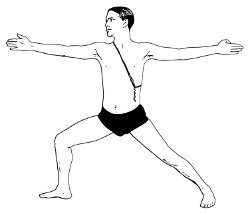 Initial position: standing with your feet wide apart, toes are parallel to each other. Torso,pelvis and legs are in the same plane.
Initial position: standing with your feet wide apart, toes are parallel to each other. Torso,pelvis and legs are in the same plane.
Turn both toes to the left while keeping the pelvis open. Inhale and stretch your palms sideward, keeping both arms at an equal distance from the floor. Exhale and bend the left knee. At first the angle between the shin and the thigh can be at more than 90 degrees, but ideally you should hold the left hip parallel to the floor and the shin – in a vertical position. Stretch the hip and the knee of the bent leg in the direction of the the knee of the bent leg, the heel of the straight leg – in the opposite direction. Hold the asana for 5-7 breaths. Return to the starting position. Switch sides and repeat. At first you the hip of the bent leg may be directed inwards, especially while performing the asana by the wall. Do not turn the pelvis, visually imitating the “opening” of the hip. Try to form the feeling of moving the hip outward, while maintaining the tonus of the muscles of the external surface of the hip, even if the result is not obvious.straining.
Effect: the asana strengthens hips and knees, frees the ankles, and opens the pelvis joints. The ribcage opens up and one's breath deepens. The asana effectively warms up the body, prepares one for more advanced asanas, develops endurance.
4. Prasarita padottanasana
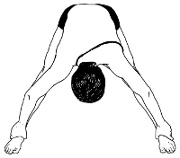 Initial position: standing with feet wide apart, toes are parallel to each other. Exhale and lower the torso, holding both ankles with your hands. Inhale, raise your head and shoulders, flex in your spine and stare ahead focusing on one point. Stay in this position for a few breaths and then bend down again relaxing the muscles along the spine and the back surface of the legs. The weight is evenly distributed across the sole. Pull your chin up slightly towards the torso, focusing attention and gaze in the direction of the pelvis to prevent the lag of the head. Tighten the abdomen muscles a little and relax the back and the back surface of the legs. This makes your pelvis gradually rotate more in the pelvis joints and to open the hips. Stay in this position for 5-7 breaths, then inhale and slowly raise your head, shoulders and torso up, and then relaxing the shoulders while exhaling.
Initial position: standing with feet wide apart, toes are parallel to each other. Exhale and lower the torso, holding both ankles with your hands. Inhale, raise your head and shoulders, flex in your spine and stare ahead focusing on one point. Stay in this position for a few breaths and then bend down again relaxing the muscles along the spine and the back surface of the legs. The weight is evenly distributed across the sole. Pull your chin up slightly towards the torso, focusing attention and gaze in the direction of the pelvis to prevent the lag of the head. Tighten the abdomen muscles a little and relax the back and the back surface of the legs. This makes your pelvis gradually rotate more in the pelvis joints and to open the hips. Stay in this position for 5-7 breaths, then inhale and slowly raise your head, shoulders and torso up, and then relaxing the shoulders while exhaling.
Effect: the position may serve as an inversion asana for beginners. It stretches the back surface of the legs, the back of the head and the muscles of the lower spine-sacrum area; the pelvis joints are turned more; the ankle-joints and feet become more relaxed. Blood gently flows to the head. In case of high blood pressure you may look at the tips of your toes, depending on the comfort level.
5. Namaskarasana
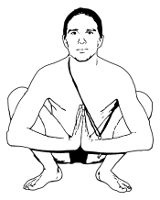 Initial position: standing with your feet 1 shoulder width apart. Bend your knees, squat down lowering the pelvis. Join your palms at the breast level, holding the elbows across the shins. Straighten the back and push the shins back with your shoulders, trying to straighten the back and lower the heels to the floor. Maintain the balance while directing your gaze at any immobile point at eye level.
Initial position: standing with your feet 1 shoulder width apart. Bend your knees, squat down lowering the pelvis. Join your palms at the breast level, holding the elbows across the shins. Straighten the back and push the shins back with your shoulders, trying to straighten the back and lower the heels to the floor. Maintain the balance while directing your gaze at any immobile point at eye level.
Effect: the asana works out the lower back and sacrum area of the spine, stretching the muscles; the ankle-joints and feet become more relaxed It also opens the chest and the cervical and thoracic spine.
6. Vajrasana
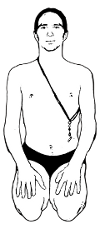 Initial position: sit down on your heels, placing the big toes on top of each other. Straighten your back and maintain slight tension along the spine. Place your palms on your hips facing down (or up – if you wish), close your eyes,relax for a minute in a steady state of mind. You breathing is natural and free.
Initial position: sit down on your heels, placing the big toes on top of each other. Straighten your back and maintain slight tension along the spine. Place your palms on your hips facing down (or up – if you wish), close your eyes,relax for a minute in a steady state of mind. You breathing is natural and free.
Effect: this asana is meant for meditation; it allows to hold the back in a straight position for a long time, prior to mastering siddhasana and padmasana. It frees the front surfaces of the hips, as well as the knee and pelvis joints.
7. Parsva marjariasana
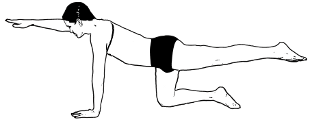 Initial position: rest on your knees and straight arms; palms under the shoulders, hips and arms perpendicular to the floor, palms (from the fingertips to the wrists) are placed firmly on the floor.
Initial position: rest on your knees and straight arms; palms under the shoulders, hips and arms perpendicular to the floor, palms (from the fingertips to the wrists) are placed firmly on the floor.
Inhale and stretch your straight left leg backward while stretching your right palm, shoulder and head forward. Pull your chin down slightly towards your torso without lowering the head, with neck aligned along the spine. Look down at the floor, not lowering your head, fixing your gaze at any immobile point on the floor. Keep your pelvis closed do not lift it. Create the feeling of evenly spaced tension along the entire line of the spine, stretching it between the hip and the shoulder blade. Exhale and lower the arm and knee. Switch sides and repeat, stretching out the left arm and the right leg.
Effect: this asana helps stretch the spine stretches, improves balance, works out the hip and shoulder muscles, as well as spinal muscles; eliminates slouching.
8. Sarpasana
 Initial position: lying flat on your stomach. Put your toes together and place them firmly against the floor. Palms and forehead are lying on the floor.
Initial position: lying flat on your stomach. Put your toes together and place them firmly against the floor. Palms and forehead are lying on the floor.
Move your chin slightly towards your chest so that the back of your head is on one line with the spine. Bring your palms forward along the floor so that they nearly touch each other, and you elbows are bent at 90 degrees. Raise your head and shoulders so that the back of the head, as well as the thoracic and lumbar section of the spine are evenly stretched forward. Do not throw your head, look in front of you and down. As a result, your cervical spine keeps working and continuing the stretching forward. Gradually relaxing the shoulders and thighs we transfer the attention and body workout to the muscles along the spine, evenly distributing the stretch and tonus along them. Try to keep your body in a raised position with the help of the back muscles, with the minimal involvement of arms and legs. Even stretching guarantees that spine muscles work correctly and results in a good body posture. This is beneficial both for meditation asanas and for everyday life. The stomach remains on the floor. In the final position, we go on controlling the back line and maintain even breathing, which with time becomes relaxed despite some discomfort at the beginning. Uneven breathing may sygnal that you are rushing and trying to bend too much, as well as an overall anxiety. You should pay attention to this, trying to even your breath and the overall inner state, and putting aside any anxiety and attempts to force mastering the asana. All beginners should form a stable perception of their actions in the asana, which will allow expanding this tendency later on. Then, while exhaling, we sequentially lower the chest, neck and head, returning to the starting position. You may repeat the asana if you wish.
Effect: apart from mastering the condition of correct concentration on your sensations, doing the asana this way has a positive effect on one's psycho-emotional state in everyday life. It brings back a clear state of mind and tones the nervous system, especially if one's job is sedentary and requires a lot of mental effort. Besides, as the back muscles along the spine are worked out, the blood circulation is stimulated and one’s posture improves. The asana effectively opens the chest and improves the lung ventilation. In cases of slight dislocation of spinal discs, the asana helps to move them back in place. All sections of the spine get toned. This asana also eliminates tension and constraint in the back and neck areas, internal organs get massaged.
9. Sasankasana
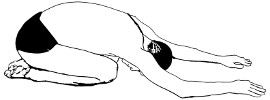 Initial position: sit down in vajrasana. Put your palms on your knees and comfortably straighten your spine. Exhale and lower your torso down on your thighs but your straight arms on the floor in front of you. Relax your shoulders, shoulder-blades, neck, face, spine column muscles, thighs and ankles. With each calm exhale your torso gently lower your torso on your thighs and relax your forearms on the floor.
Initial position: sit down in vajrasana. Put your palms on your knees and comfortably straighten your spine. Exhale and lower your torso down on your thighs but your straight arms on the floor in front of you. Relax your shoulders, shoulder-blades, neck, face, spine column muscles, thighs and ankles. With each calm exhale your torso gently lower your torso on your thighs and relax your forearms on the floor.
Effect: sasankasana relaxes back muscles, which allows to eliminate compression in the vertebral column and to relieve intervertebral disks. Deep breathing in the final position of the asana provides gentle yet powerful massage to the organs of the abdomen. Therefore, this asana is very useful in treating and preventing various digestive malfunctions, such as constipation and indigestion. The asana tones the organs of the pelvic area. It also facilitates mental relaxation, reduces the tension of the nervous system and eliminates residual effects of stressful situations.
10. Ardha kurmasana
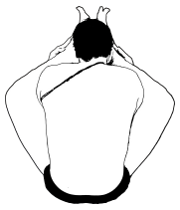 Initial position: while sitting, bring your soles together and forward so that the thighs and calves are bent at 90 degrees. Lower your palms onto the floor between your toes and pelvis.
Initial position: while sitting, bring your soles together and forward so that the thighs and calves are bent at 90 degrees. Lower your palms onto the floor between your toes and pelvis.
Exhale and lower your head, arching the spine forward and downwards. Stretch your forehead towards the toes, while the back of your head – forward and down. After that the thoracic spine stretches and causes the lumbar spine to stretch also. Maintain this even stretch and decrease it gradually so that you barely feel it. Activate and maintain the tonus in the muscles of the front surface of the neck, chest muscles, muscles of the abdomen wall, sustaining the stability of the bend through their tonus; the upper arms and elbows are trying to press against the floor. If your elbows are touching the floor, stretch them to the sides so that your shoulders attempt to "plunge" under the knees, your shoulder blades are retracted forward and down. This stretches the thoracic spine and bends it forward and down ever more.
Relax the thighs and buttock muscles; as a result, the pelvis gradually turns in the hip joints, making the lean deeper. This reduces the spine muscles stretch, as well as the strain of lower torso and neck. Stay in this position for as long as you feel comfortable, exhale and return to the starting position.
Effect: similar to those of prasarita padottanasana and sasankasana, but deeper.
11. Vakrasana
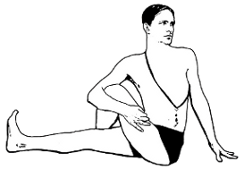 Initial position: sitting down with legs straight.
Initial position: sitting down with legs straight.
Bend your left knee and put the foot outside the right knee. Stretch the whole spine; without raising your chin, turn your head and shoulders to the left. The left palm is placed firmly on the floor; the right arm holds the left knee. Turn your head to left as far as you can. Breathe evenly. Concentrate attention on the spinal column. Stay in this asana for 5-7 even abdominal breaths. Switch sides and repeat.
Effect: the asana strengthens the spinal column and makes it more flexible. It also improves the functions of kidneys, liver, spleen and intestines.
12. Yoga Mudra in Vajrasana
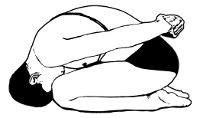 Initial position: sitting down on your heels, big toes placed one over the other. Straighten your back and maintain slight tension along the spine. Put the thumb of the left hand inside a fist; the right hand grabs the left wrist behind the back. Lower your torso onto the thighs and the forehead – onto the floor. The clasped hands rest on the lower back. Relax your torso, thighs, face and breath. Stay in this asana for 5-7 even breaths and then return to the starting position.
Initial position: sitting down on your heels, big toes placed one over the other. Straighten your back and maintain slight tension along the spine. Put the thumb of the left hand inside a fist; the right hand grabs the left wrist behind the back. Lower your torso onto the thighs and the forehead – onto the floor. The clasped hands rest on the lower back. Relax your torso, thighs, face and breath. Stay in this asana for 5-7 even breaths and then return to the starting position.

